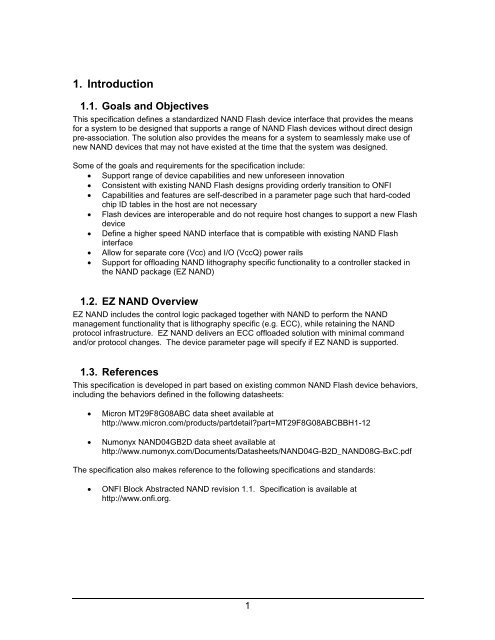Open NAND Flash Interface Specification - Micron
Open NAND Flash Interface Specification - Micron
Open NAND Flash Interface Specification - Micron
Create successful ePaper yourself
Turn your PDF publications into a flip-book with our unique Google optimized e-Paper software.
1. Introduction<br />
1.1. Goals and Objectives<br />
This specification defines a standardized <strong>NAND</strong> <strong>Flash</strong> device interface that provides the means<br />
for a system to be designed that supports a range of <strong>NAND</strong> <strong>Flash</strong> devices without direct design<br />
pre-association. The solution also provides the means for a system to seamlessly make use of<br />
new <strong>NAND</strong> devices that may not have existed at the time that the system was designed.<br />
Some of the goals and requirements for the specification include:<br />
� Support range of device capabilities and new unforeseen innovation<br />
� Consistent with existing <strong>NAND</strong> <strong>Flash</strong> designs providing orderly transition to ONFI<br />
� Capabilities and features are self-described in a parameter page such that hard-coded<br />
chip ID tables in the host are not necessary<br />
� <strong>Flash</strong> devices are interoperable and do not require host changes to support a new <strong>Flash</strong><br />
device<br />
� Define a higher speed <strong>NAND</strong> interface that is compatible with existing <strong>NAND</strong> <strong>Flash</strong><br />
interface<br />
� Allow for separate core (Vcc) and I/O (VccQ) power rails<br />
� Support for offloading <strong>NAND</strong> lithography specific functionality to a controller stacked in<br />
the <strong>NAND</strong> package (EZ <strong>NAND</strong>)<br />
1.2. EZ <strong>NAND</strong> Overview<br />
EZ <strong>NAND</strong> includes the control logic packaged together with <strong>NAND</strong> to perform the <strong>NAND</strong><br />
management functionality that is lithography specific (e.g. ECC), while retaining the <strong>NAND</strong><br />
protocol infrastructure. EZ <strong>NAND</strong> delivers an ECC offloaded solution with minimal command<br />
and/or protocol changes. The device parameter page will specify if EZ <strong>NAND</strong> is supported.<br />
1.3. References<br />
This specification is developed in part based on existing common <strong>NAND</strong> <strong>Flash</strong> device behaviors,<br />
including the behaviors defined in the following datasheets:<br />
� <strong>Micron</strong> MT29F8G08ABC data sheet available at<br />
http://www.micron.com/products/partdetail?part=MT29F8G08ABCBBH1-12<br />
� Numonyx <strong>NAND</strong>04GB2D data sheet available at<br />
http://www.numonyx.com/Documents/Datasheets/<strong>NAND</strong>04G-B2D_<strong>NAND</strong>08G-BxC.pdf<br />
The specification also makes reference to the following specifications and standards:<br />
� ONFI Block Abstracted <strong>NAND</strong> revision 1.1. <strong>Specification</strong> is available at<br />
http://www.onfi.org.<br />
1

















